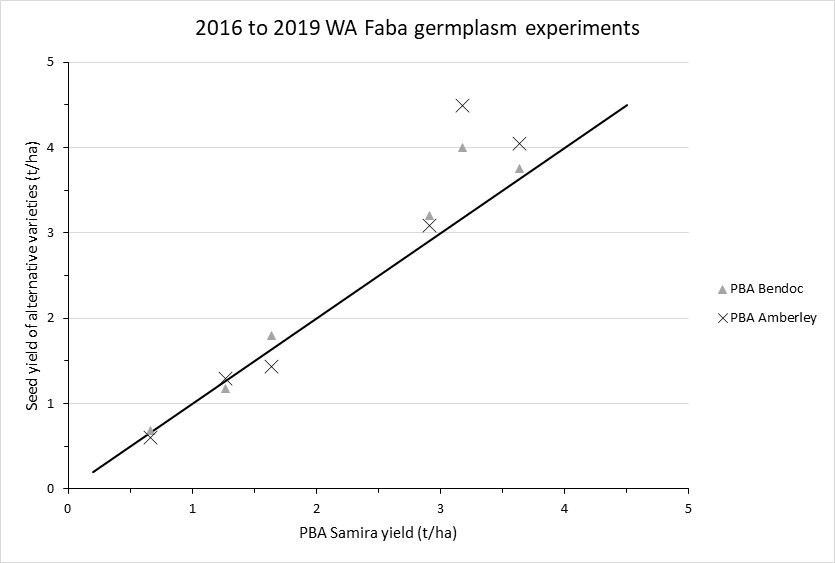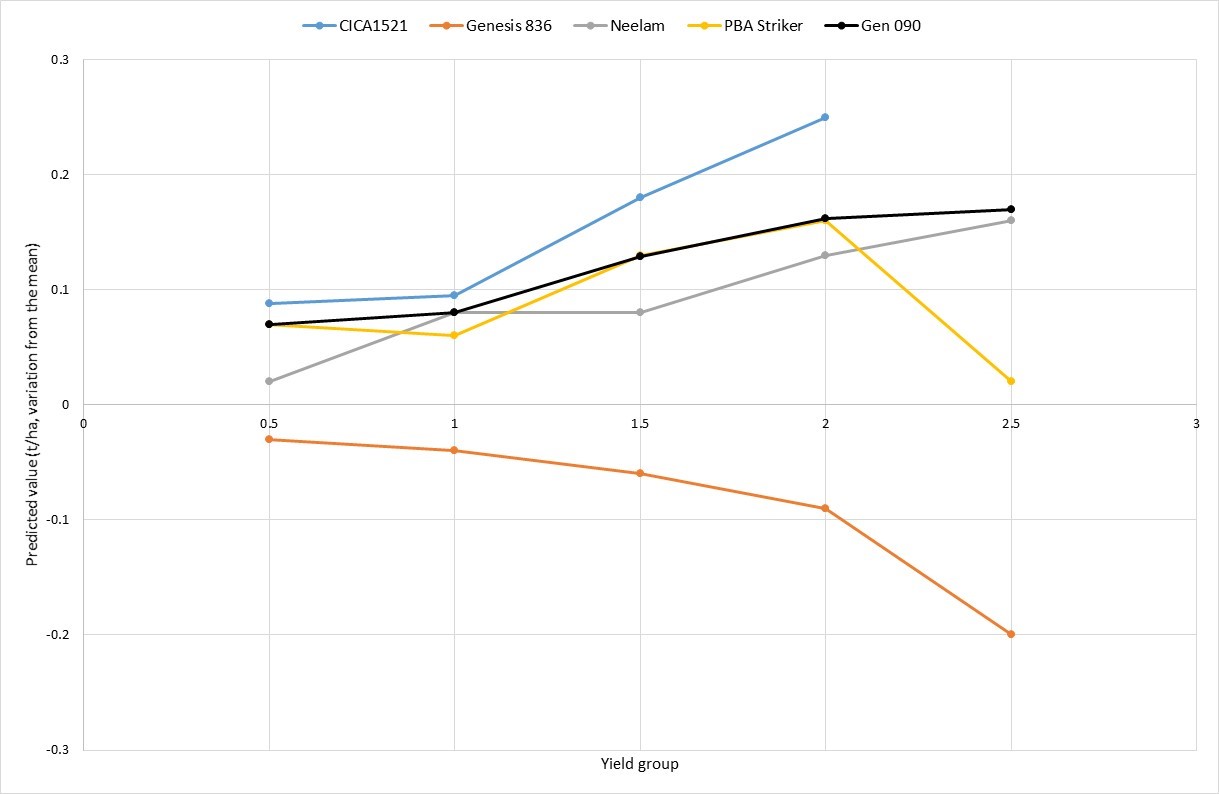Pulse agronomy and breeding update
Author: Mark Seymour | Date: 04 Feb 2020
Key messages
- CICA1521 is an exciting desi chickpea set for release in 2020 – combining class leading yield with a taller canopy that allows for easier harvesting
- Lentil growers should aim to test PBA Highland XT on their farm in 2020.
- PBA Bendoc provides faba bean growers improved broadleaf weed control options
- PBA Amberley is a faba bean well suited to high yielding/high disease pressure situations
Aims
To provide industry with a summary of the performance of recently released pulse varieties; highlight some of the promising lines evaluated in early generation experiments and update growers and consultants on products and agronomy packages to maximise pulse production in Western Australia (WA).
Introduction
Pulse breeders have released several new varieties to Australian growers in recent years that, combined with improved agronomy, has seen the development of successful chickpea industries in New South Wales and Queensland and lentil and faba bean industries in Victoria and South Australia. In contrast, during the same period, the area sown to canola in WA has increased, resulting in less legume area. This has raised some concern over the lack of diversity in WA rotations and an over reliance on synthetic nitrogen. With the success of pulse industries in the Eastern States, many WA farmers and their consultants are rethinking the place of legumes in their rotations, particularly the high-value pulses such as chickpea and lentil.
Combined with improved agronomy and new generation weed and disease control products, many of the newly released or soon-to-be released pulse varieties offer WA growers unique opportunities to overcome some of the barriers to pulse adoption.
Method
In this paper, we summarise results of early generation pulse experiments – Stage 2 and 3, near release trials (Stage 4) and key variety x agronomy experiments. Individual trial details are available from NVT online (https://www.nvtonline.com.au) and the Online Farm trials website (https://www.farmtrials.com.au/).
Results
Faba bean – clean beans!
Faba bean prices have been very attractive to growers in recent years, tracking at over $500/t. In the Albany port zone there is considerable interest in faba beans as they could offer a useful addition to cereal-canola rotations, particularly in wetter areas where narrow-leafed lupin often fail.
Two new varieties released by Pulse Breeding Australia (PBA) are likely to prove very useful to WA growers.
PBA Bendoc is the first imidazolinone (IMI) tolerant faba bean variety to be released in Australia, which will provide more in-crop broadleaf weed control options and enable the variety to be grown where some Group B (including the sulfonylureas) herbicide residues persist from applications in the previous crop. Nufarm has an APVMA permit (PER86849) for their Nufarm Intercept herbicide containing: 33g/L imazamox and 15g/L imazapyr to be used at rate of 750mL/ha applied at the 2 to 4-leaf stage of PBABendoc.
PBA Amberley was released in October 2019. It has the highest rated resistance to chocolate spot (Botrytis fabae) of any Australian faba bean variety. We have been keeping a close eye on this variety for several years and have been impressed with the low levels of chocolate spot infection in all of our WA experiments. It also shows consistently less ‘necking’ than all other varieties, where the stem bends over sharply, virtually snapping at about pod height, so the upper part of the plant either dies or becomes less able to assist in grain-fill. Necking usually occurs under strong winds or when plants are under moisture stress. The combination of less chocolate spot risk and less necking makes PBA Amberley well suited to high-yielding situations.
PBA Amberley and PBA Bendoc have similar yields to PBA Samira at sites yielding less than 2t/ha (Figure 1). At sites yielding 3t/ha or more, PBA Amberley and PBA Bendoc have, on occasions, produced higher yields than PBA Samira.

Figure 1. Seed yields of PBA Amberley and PBA Bendoc compared to the most widely grown faba bean variety in WA, PBA Samira. (Data from NVT and Stage 2 and 3 experiments, 2016-19).
Lentil
The Esperance port zone is the main lentil growing area in WA. In 2019, a significant lack of rainfall resulted in a very tough year for the burgeoning lentil industry. Many crops yielded less than 600kg/ha and several experiments were unable to be machine harvested. In other parts of WA, our lentil experiments performed quite well. At Dalwallinu, yields were as high as 1t/ha, Mingenew 600kg/ha and Dongara 2.5t/ha. At these yield levels and with grain prices in the range of $420 to $480/t lentils ranged from breakeven to very profitable in central and northern parts of WA in 2019.
Released in 2019, PBA Highland XT is a herbicide tolerant red lentil variety that will complement other tolerant varieties such as PBA Hallmark XT and PBA Hurricane XT. PBA Highland XT is earlier flowering than other XT lentil varieties and has improved ascochyta resistance.
PBA Highland XT is on average 5% higher yielding than PBA Hallmark XT and 2% higher yielding than PBA Bolt in WA. XT lentils provide growers in WA an option to use IMI chemistry in-crop, which will be particularly useful if they are growing lentils on lighter textured soil types where Group C (e.g. terbuthylazine, diuron) herbicide damage in lentil is often a problem.
Chickpea – taller and higher yielding
In 2020, Kristy Hobson from NSW DPI and PBA plan to release a new desi chickpea CICA1521 to Australian growers. CICA1521 has an erect plant type, early-to-mid flowering and maturity and medium seed size. Trials to date indicate CICA1521 produced yields equal to PBA Striker, Neelam, Genesis 836 and Gen 090 at site yields of 0.5 to 1t/ha and higher yields when site yield was 1 to 2t/ha. Of particular interest to growers will be CICA1521’s taller canopy, which should make pods easier to harvest in WA. For example, at the NVT site at Merredin in 2019 we measured the canopy of CICA1521 to be 9cm higher than PBA Striker in mid-September. CICA1521 will have a similar ascochyta rating to PBA Striker.

Figure 2. Seed yields of chickpea in WA. Data up to and including 2018 from NVT MET (2019 data not available at time of publication).
Conclusion
Growers in WA now have access to new varieties that offer improved herbicide tolerance, improved disease resistance, higher yields and improved harvestability over previously available varieties. The new pulse varieties should overcome some of the barriers to pulse adoption in WA.
Acknowledgments
The research undertaken as part of this project is made possible by the significant contributions of growers through both trial cooperation and the support of the GRDC and DPIRD, the author would like to thank them for their continued support. Data and cultivar information have been provided by PBA and NVT.
Contact details
Mark Seymour
Department of Primary Industries and Regional Development, Esperance
Melijinup Road, Esperance WA 6450
08 90831 143
mark.seymour@dpird.wa.gov.au
Reviewed: Stacey Hansch
Varieties displaying this symbol beside them are protected under the Plant Breeders Rights Act 1994.
GRDC Project Code: DAW1903-004RTX, DAV00154,
Was this page helpful?
YOUR FEEDBACK
